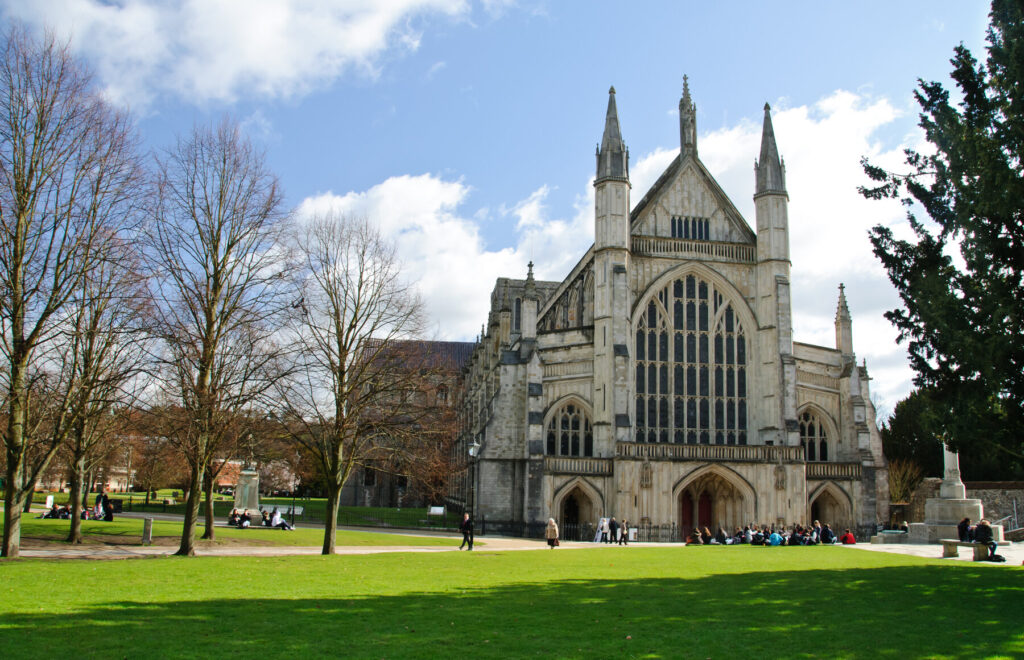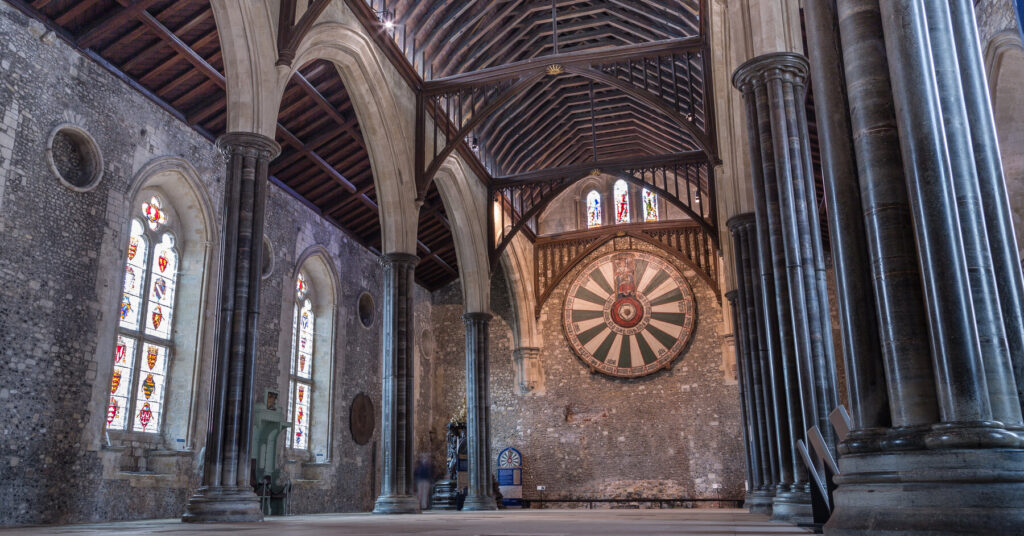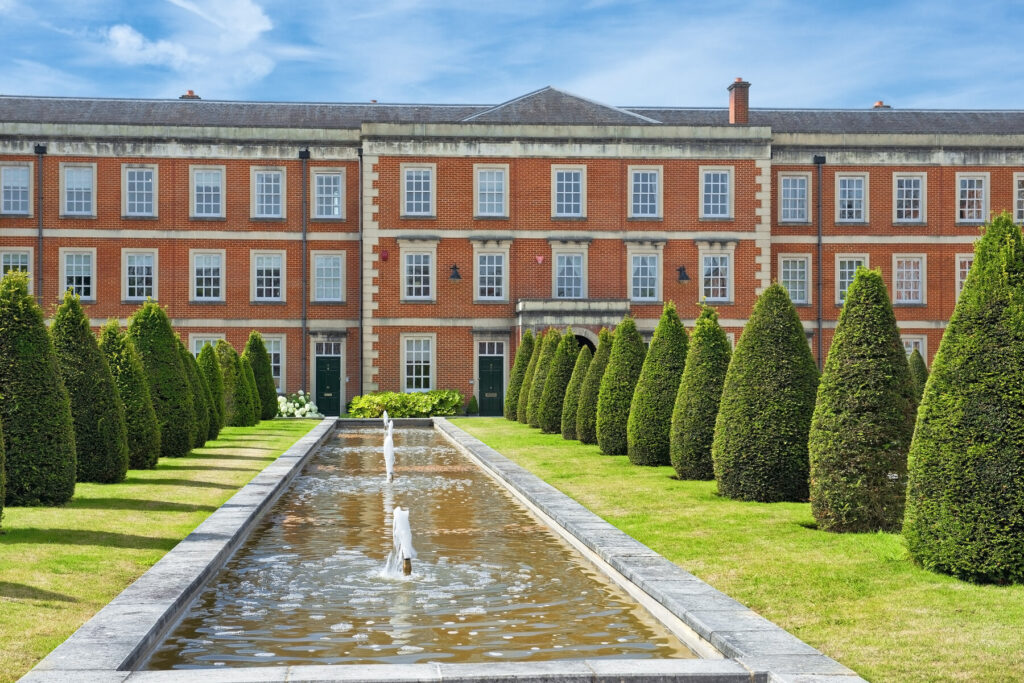Sitting on the edge of the South Downs in Hampshire, Winchester has long been associated with some of our most famous kings. In Saxon times, King Alfred based his court and capital here as he led resistance against the Vikings. Later Winchester’s Great Hall became associated with the legends of Arthur and Camelot, while other royalty from Cnut to Charles I can be found in the city’s medieval cathedral.
William the Conqueror built a castle in Winchester and Charles II planned a palace which was never completed. Instead it became a military barracks where today you can discover the stories of soldiers and regiments who have served the British cause over the past 300 years.
What to see and do in Winchester
Day one
Start near the foot of the High Street as it becomes The Broadway, where a bronze statue of King Alfred stands, brandishing a sword above his head. The statue, which is 17ft tall, has been here since 1899, the 1000th anniversary of Alfred’s death. Its beard may owe more to imagination than reality, however, as coins from Alfred’s reign depict him as clean-shaven.
A few minutes’ walk along the High Street, turn left past the old Market Cross to find the City Museum. Across three floors, this provides snapshots of life from Venta Belgarum (the settlement the Romans established here), the Anglo-Saxon and medieval periods, and Victorian and Edwardian times. We love the 12th-century bronze horn, with four lions and two bishops as decoration, whose
sound embellished city meetings and functions, and the enormous scale model representing the city in 1870.

Turn left out of the museum for the impressive spectacle of Winchester Cathedral. Enter by the northwest door and pause at the West End, where statues of James I and Charles I stand under a vast stained-glass window that once depicted the life of Christ with apostles and prophets on either side. Parliamentary soldiers smashed the glass during the Civil War, but the pieces were later reassembled at random, which gives a pleasing abstract effect.
From here, walk down the nave which, at 246ft, is the longest surviving nave of any medieval cathedral in the country. Its early construction in the 1080s and 1090s featured Romanesque rounded arches; a remodelling three centuries later used pointed arches and large openings in the Perpendicular style, allowing more light inside. A brass memorial plaque on the left, with an accompanying black slab in the floor nearby, commemorates the life of Jane Austen (1775–1817), who died in Winchester and was buried in the cathedral.
Sitting on the screens in the presbytery are six wooden chests with crowns on top. These mortuary chests contained the remains of monarchs and bishops from before the Norman Conquest, and may have included Queen Emma, wife to kings Cnut and Ethelred the Unready and mother to Harthacnut and Edward the Confessor. The results of continuing scientific analysis on the bones are displayed in a special ‘Kings & Scribes’ exhibition, along with the four bound volumes of the 12th-century illuminated Winchester Bible, one of the finest surviving medieval manuscripts.
The cathedral’s most unexpected monument is a small bronze figure of a deep-sea diver by the Langton Chapel. This is William Walker who, for six years up to 1911, dived into the flooded foundations to carry and lay sacks of concrete. His efforts enabled a team of 150 workmen to rebuild the foundations and save the building from collapse.

A few minutes away via St Swithun Street (named after one of the city’s saints, who was its bishop from 852–63AD) is the Great Hall. Henry III, who was known as Henry of Winchester before becoming king in 1216, commissioned the building of this imposing aisled hall close to the castle (of which little remains), and it has served as a court for much of its history. The hall’s highlight is high on the wall at one end: the Round Table, 18ft in diameter, weighing over a ton and made from 121 pieces of English oak. Tree-ring and radio carbon dating suggests that the table was made in the late 13th century, possibly by order of Henry’s son Edward I, a strong believer in the legends of Arthur and the knights of the Round Table.
The design you see today, depicting Arthur with sword and orb, 24 knights’ names around the rim and a Tudor rose in the centre, came later, on the orders of Henry VIII. X-rays have shown that the original artwork of Arthur’s face was, in fact, a likeness of a young Henry VIII – a none-too-subtle reminder of Henry’s claim to the throne as Arthur’s direct descendant.
Day two
A short walk from the Great Hall is the site of the King’s House, the palace which Charles II commissioned Sir Christopher Wren to build, but which Charles’s successor James II abandoned. It housed French, Dutch and Spanish prisoners of war, and served as a barracks for 200 years, with some of the buildings now residential developments. On the same site, the Military Quarter houses six museums which examine and celebrate the lives of soldiers.
The Adjutant General’s Corps Museum traces the history of the various corps that eventually merged into the AGC and gives a useful overview of army developments since 1700, including
training and pay. One sound recording recounts how an officer explained the underpayment of a soldier by £300, just after World War II, by claiming that a fly had landed on the paperwork, obscuring the crucial figure.
Next door, the Royal Green Jackets Museum explains how four different regiments, precursors of the Green Jackets, served Britain in various wars. An excellent diorama of the Battle of Waterloo, which features models of 9,000 horses and 21,500 soldiers, is helpful if you have little prior knowledge of that crucial conflict.

The Gurkha Museum pays tribute to the cultural heritage of the Gurkhas’ home nation of Nepal. The Gurkhas and the British were adversaries in the 1814–16 Anglo–Nepalese War. Later the British recruited Gurkhas to fight for them in Afghanistan, the Falklands and elsewhere. HorsePower, which is the museum of the King’s Royal Hussars, the Rifles Museum and the Royal Hampshire Regiment Museum offer further
insights into military life.
Practicalities
Where to stay in Winchester
Winchester Royal Hotel can trace its history back over 400 years; the welcoming ambience, well-appointed bedrooms and walled garden make for a relaxing stay. Other options include bed and breakfast at The Black Hole, suites at Two Bare Feet or – just west of Winchester – the luxury of Lainston House.
Where to eat and drink in Winchester
There are plenty of bustling cafés, including The Square and Café Monde, both around the corner from the cathedral. On Jewry Street ten minutes away, Dim T, one outlet of a small Hampshire/London chain, serves good-value Asian fusion food.
Travel to Winchester
Winchester is an hour from London Waterloo by train (SW), with good links to Birmingham and points further north. The main road is via the M3 or, from Newbury or Oxford, the A34.
More information
For more information, see our guide:
